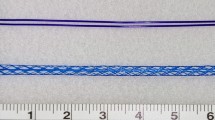Abstract
Background: In laparoscopic inguinal herniorrhaphy, meshes commonly have been fixed with a stapler. Recently, a new mode of fixation using a helical fastener has been introduced. The purpose of this experimental study was to compare the stability achieved by various types of mesh fixation.
Methods: In 20 human cadavers, polypropylene meshes 10 × 15 cm in size were fixed in both groins by using either a helical fastener or a hernia stapler (4.8 mm). The mesh was fixed with 2, 4, and 8 elements and stressed with a dynamometer until the prosthesis ruptured. A paired and two-sided Student's t-test was used for statistical evaluation.
Results: With the helical fastener, the mesh could be fixed always at the desired site. However, with the stapler, it was not possible to fix the mesh in the pubic bone or, at times, in the Cooper's ligament. When two fixation elements were used, the mesh fixed by the helical fastener was able to withstand a median load of 34 N (range 23–53 N), and that fixed by the stapler 7.5 N (range 3–12 N; p < 0.001). When four fixation elements were used, the mesh fixed by the helical fastener was able to withstand 70.5 N (range 53–80 N) and that fixed by the stapler 17.5 N (range 4–25 N; p < 0.001). With the use of eight elements, the mesh fixed by the helical fastener withstood 127 N (range 84–156 N) and that fixed by the stapler 32.5 N (range 15–59 N; p < 0.001). Thus, in all cases the helical fastener was significantly more stress resistant. The main reason for detachment of the mesh was tissue disruption or deformation of the fixation elements. Only when a stress of more than 130 N was applied did the mesh tear in two cases.
Conclusions: The stress-bearing capacity (shear force resistance) of a mesh fixed by a helical fastener is up to four times that of a mesh fixed by a stapler. Therefore, the helical fastener provides significantly more stable fixation and will be able to protect the patient better from recurrent hernias caused by mesh migration.
Similar content being viewed by others
Author information
Authors and Affiliations
Additional information
Received: 10 August 1998/Accepted: 26 March 1999
Rights and permissions
About this article
Cite this article
Hollinsky, C., Göbl, S. Bursting strength evaluation after different types of mesh fixation in laparoscopic herniorrhaphy. Surg Endosc 13, 958–961 (1999). https://doi.org/10.1007/s004649901146
Published:
Issue Date:
DOI: https://doi.org/10.1007/s004649901146




